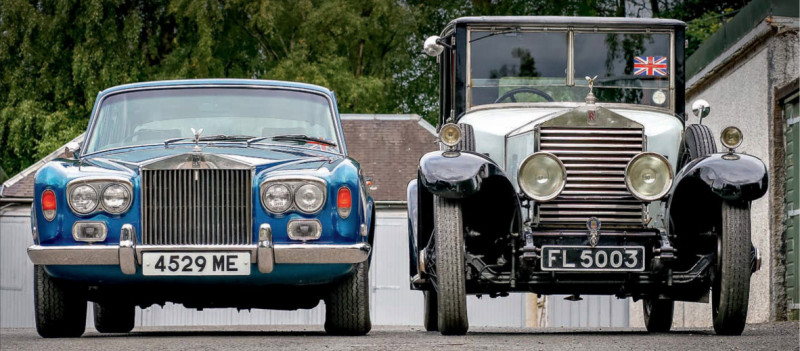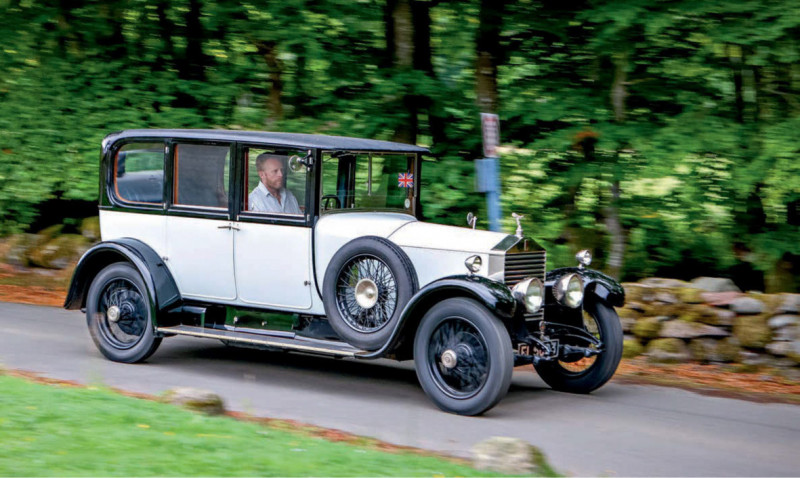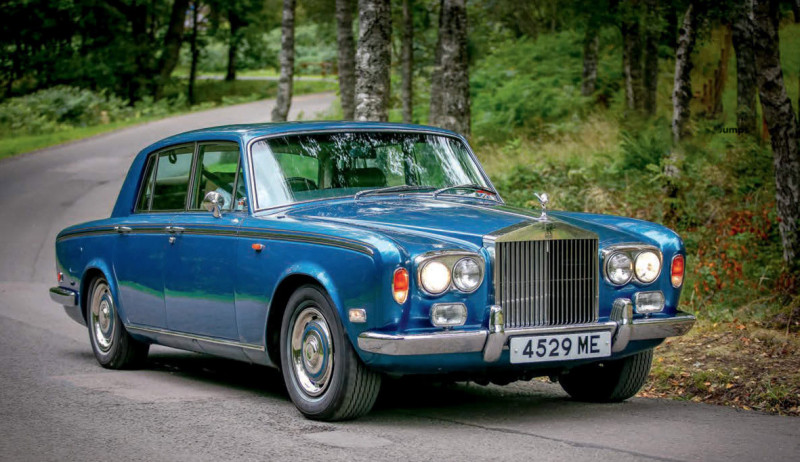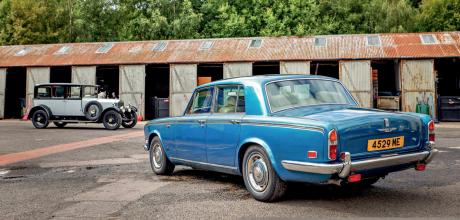1926 Rolls-Royce 20hp Saloon by Hooper vs. 1976 Silver Shadow
Though built 50 years apart, these two have something in common: both were make-or-break models for Rolls-Royce. We visit the man who owns them, and drive each car to see how the company’s unique qualities persisted across half a century.
WORDS: NIGEL BOOTHMAN
PHOTOGRAPHY: LEWIS HOUGHTON
TRAILBLAZERS
WE DRIVE TWO KEY MODELS BUILT 50 YEARS APART – DOES THE ROLLS-ROYCE DNA SURVIVE?
SILVER SHADOW & ‘TWENTY’
Two cars with the same owner give us a rare chance to compare Rolls-Royces constructed 50 years apart – will they share anything, beyond the name?

It’s quite a thing to risk a reputation. All the more so if it’s a reputation like that of Rolls- Royce, already vastly respected by 1920 when a smaller model was first considered. By 1965, when the Silver Shadow was launched, Rolls- Royce had become part of the lexicon – stick ‘The Rolls-Royce of…’ to the beginning of any product’s description and the world understood you.
Both of these cars, then, had the potential to do a great deal of damage to the reputation established by their predecessors. In the case of the 20hp, it was asked to join the 40/50hp Silver Ghost. This was, of course, called the best car in the world with much justification. It was also the only model Rolls-Royce had made since November 1906. Would shifting back to a two-model approach, with a smaller and less costly car partnering the imperious Ghost, do irreparable damage to the company image? It would, if the new car wasn’t good enough.

Then, in the late 1950s, the company was seriously considering an expansion from two models (the Silver Cloud and the ageing, coachbuilt Silver Wraith) to four, if you include the special-order Phantom V that took on the uppermost coachbuilt niche. The smaller three would all be based on new monocoque chassis-body units across three different wheelbases: a short, V8-powered Continental-type coupé badged as a Bentley and codenamed Korea; a medium-sized saloon with a 4-litre, six-cylinder engine badged as either a Rolls-Royce or a Bentley (codenamed Tonga and Burma), and the same arrangement for a larger V8 saloon, codenamed Tibet and Borneo. Unsurprisingly, the costs of tooling up for this lot were soon judged to be insupportable, leaving all the company’s eggs in one basket – the larger V8 saloon. Could it satisfy the traditionalists as well as those who expected a new Rolls-Royce to be at least as powerful, capable and modern as the best that Daimler, Cadillac or Mercedes had to offer?

We know, of course, that it all turned out alright. As it did in 1922 when the car code-named Goshawk was launched as the Rolls-Royce 20hp, or Twenty. Indeed, the Twenty went on to out-sell its larger stablemates, while its descendants carried Rolls-Royce and Bentley through to the outbreak of war. Likewise, the Silver Shadow soon persuaded those who drove it that blending American-style V8 engines and automatic gearboxes with Citroënian high-pressure hydraulics could somehow produce a marvellously refined British luxury car. It lived on in the company’s range for 15 years as a saloon model but far longer as a two-door coupé and convertible.
On a sunny day in Scotland, we travelled to Crieff in Perthshire to meet a man who has one example of each of these distant but vastly influential and important models. Can they really have anything in common beyond the Rolls-Royce grille and Spirit of Ecstasy?
A MAN OF TASTE
We’re guests of Stephen Leckie, one of the busiest men I’ve ever met. He is at the helm of a group that runs, amongst other interests, the Crieff Hydropathic Establishment, a Victorian-built health spa and hotel nowadays universally known as Crieff Hydro. The group also looks after Peebles Hydro, the only other survivor of 20 such establishments that once offered healthful holidays to Britain’s well-off travellers. Stephen is the great-greatgr-and-nephew of Dr Thomas Henry Meikle, Crieff Hydro’s founder.
Stephen also finds time to serve as Lord Lieutenant of Perth and Kinross, the King’s representative for the region. In addition, he serves as chairman of the Scottish Chambers of Commerce and as chairman of the national tourism board. To unwind from all of that, he takes himself off to the garages near his house and works not just on his own collection of classic cars but a collection that the Hydro has started to reflect its history. These collections include many makes and models from different eras so it’s not surprising that it features two Rolls-Royces which are wildly different.

‘One of my ancestors apparently owned the first motor car in Crieff’ says Stephen, ‘which was said to be a Rolls- Royce. We suspect it was a Twenty, so about ten years ago we began looking for one. We found this car with its nice ‘FL’ number plate with Richard Biddulph at Vintage & Prestige, and it felt a bit like fate – my wife Fiona’s initials are FL. We had an overdrive fitted and in February 2014 we drove it back to the Hydro over two days.’
This became a bit of an adventure, as they encountered wintry weather on the way home. ‘We had to stop and buy blankets, jackets and duct tape to seal up the opening windscreen because snow was getting in, and there’s no heater – we were frozen! Then the battery went flat during our overnight stop at Gretna Green and I had to ask one of the hotel staff to help push, and we bump-started successfully.’
Stephen found that the overdrive lowered the revs at 50mph but didn’t add any speed, and he recorded 16mpg overall. The car, a 1926 six-light saloon by Hooper, was skilfully rebuilt by a previous owner and since coming into the Hydro’s ownership the only other major expense has been a new radiator at an eye-watering £5000. The Silver Shadow came along more recently, in 2017, to fulfil a desire for ‘a gentlemanly classic Rolls-Royce we could really use,’ as Stephen puts it. Both cars are used for weddings and the Silver Shadow takes Stephen and colleagues to the NEC for the Classic Motor Show where the Company exhibits, and has done its duty for Stephen’s Lord-Lieutenancy on a trip to greet HRH The Princess Royal.
‘It’s a majestic, wafting sort of car,’ says Stephen. ‘My friend’s dad had one and my pal used to be allowed to take it to the pub, which I thought was quite cool in 1984 or ’85.’
This example was chosen for its lovely colour and overall condition, the only let-down being a cam lobe worn out by one of the oil pumps for the hydraulic system. This became an engine-out fix, which gave Stephen the chance to inspect and protect the subframe, putting it all back together again in properly smart condition. ‘I pressure-wash all the cars really thoroughly underneath and when they’re dry, protect them with anticorrosion paint. I use a company called Pronto Paints; they make all sorts of products that protect oil rigs and so on. Then I know I can use the car all year round without worrying.’
DRIVING BACK… 97 YEARS
Our first outing is in the Twenty, so it’s time to get my brain into vintage car mode. The pedals are conventionally placed, but the gear lever is on the right and somewhat concealed under my thigh. There’s another lever by the same side of the seat, this time for the Barker headlamp-dipping arrangement. So we switch the ignition on and then press the starter bar, left of the clutch pedal. A moan, a bit of a whirr, and… nothing. Is it running? You need to look at the oil pressure gauge climbing upwards to be certain. If you had to rely on gauges, back in 1926, to know whether your engine had started, that was surely a remarkable car.
A Twenty is very low geared and first is to be regarded as a hill-start gear, really, with second quite adequate for gentle getaways on the flat or when pointing down a gradient. Indeed, first is so low that you’re doing barely 10mph up a steep hill when the engine sounds busy enough to change up. But you can’t – you haven’t got time to get the double-declutching process done before the car has slowed again. What you need is patience. Just climb the hill, then worry about going faster.
Third is a parade gear on the flat, allowing the car to crawl along smoothly at walking pace.
Even top is very, very flexible and can let you drop below 20mph and still pull away cleanly. If pushed, it would carry you to 55 or perhaps 60mph with this bodywork, but in practice 50mph is plenty. The brakes are quite good for the day, being assisted by a mechanical servo, but an emergency stop from 50mph would demand a big gap to the car in front – it’s the small contact patches of vintage-era tyres that ultimately limit braking performance. The steering is heavy but accurate, with only the damping giving some cause for concern. Crossing a sleeping policeman at a slight angle, and at only 10 or 15mph, sets up an alarming shimmy that suggests the lever-arm dampers could do with more friction to control the front axle.
The gearchange, which is forgiving, quiet and well-engineered in feel, is not terribly slick through the gate. It made me think of R-R’s chauffeur school, and how helpful it must have been to anyone wishing to drive the cars properly. Yes, that goes for Ghosts and New Phantoms too, but ‘small Rolls- Royces’ need more attention to how the engine and gears are used, if progress is to be seamless while maintaining a useful speed. I would love to know the nature of those lessons and to find out whether they made things easier or whether it was a restrictive style of driving. Nowadays, the best advice for anyone new to a Twenty is probably ‘get it in top and leave it there,’ which takes care of most roads and roundabouts, but won’t work on long hills.
It has a tall, teetering vintage charm, and you feel as though you’re sitting on it rather than in it, despite a whole tophat’s worth of headroom above your scalp. Looking around me, I realise this car needs passengers, a lovely sunny day and a nice place to go – it’s very much a car for a picnic in the country, or a point-to-point or a car show, with no pressure to compete with moderns on busy roads or to get there in a hurry. There are some lovely details, too. The driver’s door has a splendid window lowering and raising lever which is the way everything should have been done from 1926 onwards, when Hooper fitted it to this car. It may be an even older idea than this, but it’s the earliest example I’ve come across. Quick, quiet and efficient, it’s nonetheless fitted to the driver’s door only – were little window-winding handles seen as more genteel for the passengers, while the burly chauffeur was content to operate a man-sized lever? As Stephen points out, this is really an owner-driver body, with individual front seats and no division, so a chauffeur may never have found employment here.
TECHNICAL TRIUMPH
To the Silver Shadow, then – and what a beautiful colour. It’s a kind of peacock blue with two gold pinstripes and it looks wonderful against the polished stainless steel and chrome of the brightwork. Though in cosmetically excellent shape, this car is nicely worn-in and the driver’s seat gives you a full five or six-inch drop to the base of the squab springs.
Rather akin to the Twenty, I here found myself glancing at the ammeter to see if it was flicking slightly, as it would with the engine idling. In such a well-insulated car it’s not always clear when the engine’s caught, and therefore when to let go of the ignition key. That silence continues as you slip into ‘D’ and move away. The automatic change is butter-smooth and the fingertip steering drives just as we’ve come to expect from an earlier Silver Shadow, with a slight delay between inputs and response, thanks partly to the steering box and also to the big Avon sidewalls. It has cruise control – a covetable feature on a car so well suited for long trips.
The brakes, always reassuringly potent on SY and SZ-generation cars, have some modulation in their design, including a conventional master-cylinder circuit. This familiar pedal feel allows someone un-used to a Silver Shadow to jump in and drive it normally, without causing the front seat passenger to perform a Mick Jagger impression on the windscreen. In that, it differs from Citroëns of the era, an improvement Rolls-Royce was keen to engineer into the Silver Shadow.
The reaction of pedestrians, cyclists and other motorists here in Crieff is interesting; they don’t point, smile and wave as they do when they see the Twenty, but they know what the Silver Shadow is and seem to afford it a quiet admiration and respect. Find an open road and the graceful blue saloon will pick up her skirts and dash away; there is plenty of torque low down and enough power to follow as the revs rise. In this respect, it differs utterly from the Twenty, which was created before motorways were dreamed of and when 60mph was 50% faster than most cars could manage.
So what of the similarities? Both cars are, by the standards of their respective days, paragons of virtue when it comes to insulating the occupants from the road. The 20hp is by no means silent outside, but oddly enough it’s very, very quiet inside, where it matters. I’d love to say the ride is comparable, but you can’t expect a vintage car with leaf springs and friction dampers to respond in the same way as a monocoque car suspended on coils and telescopic dampers, and with much fatter, more deformable tyres, too.
Both have lovely dashboards and large, thin-rimmed wheels, and both have plenty of room inside – they are extremely nice places to be. The Twenty is only small by Rolls-Royce standards of the day; it’s still a large car. And here we’re into a discussion of luxury, which is very difficult to achieve in a car without space. No luxury of space, no luxury at all. It’s why Rolls-Royce should resist building smaller, sportier cars…
but that’s an argument for another day. What we’ve found in this enchanted corner of Perthshire is a pair of cars that ought to be like chalk and cheese, and yet have a common thread of genetic material that you recognise the moment you enter them. They get the job done quietly, without fuss, and with gentle inputs from the driver. For passengers, insulated from the road and unaware of the radically different feel of the controls, the similarity must be greater still. Well done, Rolls-Royce, on both counts. Reputation intact.
“The Silver Shadow is as complex as the Twenty is straightforward, but both were built to be as quiet and comfortable as possible with the technology of the time.”
TECHNICAL DATA 1976 Rolls-Royce Silver Shadow
- LENGTH: 5169mm / 16ft 11 ó
- WIDTH: 1803mm / 5ft 11
- WEIGHT: 2108kg / 4648lb
- ENGINE: 6750cc OHV V8
- MAX POWER: 200bhp (est)
- MAX TORQUE: 300lb ft (est)
- 0-60MPH: 11.0s
- TOP SPEED: 118mph
- COST NEW: £19,662, 1976
Much less airy than the Twenty, but snug and serene. Silver Shadow's mass and soft suspension combine to iron out bumps.
“It has a tall, teetering vintage charm, and you feel as though you’re sitting on it rather than in it, despite a whole top-hat’s worth of headroom above your scalp.”
TECHNICAL DATA 1926 Rolls-Royce 20hp Saloon by Hooper
- LENGTH: c. 4520mm / 14ft 10
- WHEELBASE: 3275mm / 10ft 9
- WEIGHT: 1780kg / 3924lb (est)
- ENGINE: 3127cc OHV straight six
- MAX POWER: 50bhp (est)
- MAX TORQUE: 90 lb ft (est)
- 0-60MPH: Yes, probably
- TOP SPEED: c.60mph
- COST NEW: c. £1850, 1926
Flag represents Lord Lieutenant's office. Progress is smooth, quiet, unhurried — and great fun Stephen (right) likes talking cars almost as much as he enjoys working on them The '20hp' refers not to the engine's output but to its old road tax bracket. It's a smooth 3.1-litre 'six'.
Silver Shadow's engine has more than twice the capacity and about four times the output of its ancestor
“What we’ve found in this enchanted corner of Perthshire is a pair of cars that ought to be like chalk and cheese, and yet have a common thread of genetic material that you recognise the moment you enter them.”
HOOPER’S ROLE IN ROLLS-ROYCE HISTORY
‘Hooper was, quite simply, the best’. So said Nick Walker in his excellent A-Z of British Coachbuilders, and that was indeed the perception of this London firm since before the internal combustion engine came to be. They were founded in 1805, and by 1830 had a Royal Warrant, becoming coachbuilder to Queen Victoria for 60 years. By the 1920s, they were turning out the best-appointed and most expensive bodies on Rolls- Royce, Daimler and Bentley chassis, usually at the more dignified end of any styling trend. They survived, like Rolls-Royce, when others of lesser reputation bit the dust in the Depression years of the 1930s. Hooper’s post-war production was influenced by the firm’s wartime acquisition by the BSA combine. This included Daimler and was overseen by BSA’s chairman Sir Bernard Docker, who in 1949 married Norah Collins, an ex-nightclub dance hostess who had already been married twice to wealthy businessmen. Through her influence and flair for publicity, Docker commissioned a series of extravagant Daimler show cars bodied by Hooper but which featured design and styling cues used on production models like the Empress and indeed on Hooperbodied Rolls-Royces of the time.
When it became clear in 1959 that the new Rolls-Royce planned for the replacement of the Silver Cloud would not have a separate chassis, Hooper’s management knew the game was up, and the firm was closed by BSA before later being reborn as a Rolls-Royce dealer in 1970. By 1981 it had once again been appointed an officially approved Rolls-Royce coachbuilder and began completing special commissions to order. Many of these were in fact on Bentley-badged cars and varied from the fitting of bespoke cocktail cabinets to radical re-bodies like the two-door Empress coupé created for a Japanese buyer in 1990, or a few rather handsome and successful two-door Turbo R models. As far as we know, the last car they created was completed in 1994 – does anyone know different? And who has a twodoor turbocharged Hooper Bentley they’d be willing to let us try?


